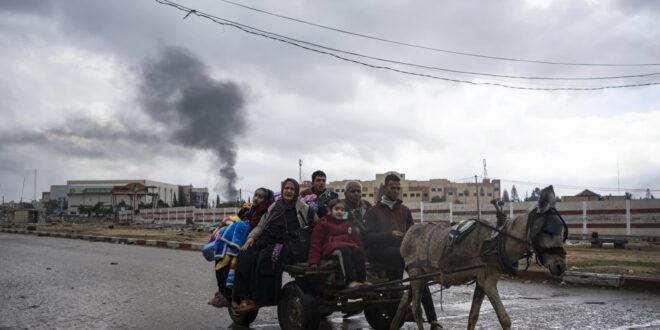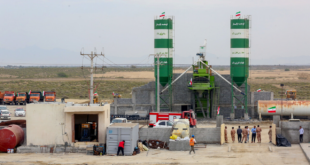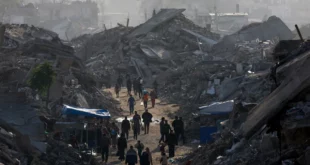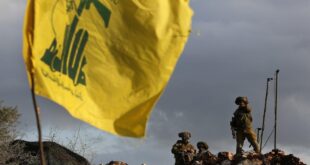Clouds of parachutes ease the descent of boxes of food toward a landscape of shattered houses in Gaza, watched by Palestinians facing famine. In Tel Aviv, Israeli protesters stand against a police water cannon as they urge the government to make a deal for the release of hostages held by Hamas.
Associated Press photographers have captured what six months of devastating war have brought for Israel and for Palestinians. The images may be disturbing to some viewers.
In Gaza, Israel’s siege, bombardment and offensive have created what U.N. and aid officials call a man-made crisis of near-starvation. Several hundred thousand Palestinians in northern Gaza face imminent famine, with little aid able to reach them, the U.N. says.
In Gaza’s southernmost city, a crowd of children and men thrust their pots and bowls out for meals being distributed by an aid group. An impromptu tent city has blanketed the edges of Rafah, filled with hundreds of thousands of Palestinians who fled Israel’s offensive in other parts of Gaza. The influx has swelled Rafah to some 1.4 million people, some five times the normal population.
Meanwhile, each day brings more death as strikes topple buildings with families inside. Six months of war have killed more than 33,000 Palestinians, according to Gaza’s Health Ministry.
In one photo, a girl looks on in shock as a man carries a child out of the rubble of a building in the southern city of Khan Younis, which has been the focus of Israel’s ground offensive for the past months. With entire blocks now in ruins, parts of Khan Younis are starting to resemble Gaza City in the north, where some estimates say around 70% of buildings have been destroyed or damaged.
In Israel, the public is still gripped by grief and anger over the images from Hamas’ Oct. 7 attack, which triggered the war. Storming out of Gaza, the militants rampaged in southern Israeli towns, leaving streets strewn with bodies and entire families killed in their homes. They killed around 1,200 people, most of them civilians, and abducted around 250 others. After a round of releases during a November cease-fire, Hamas still holds an estimated 100 hostages, along with the bodies of around 30 others.
But divisions have begun to open among Israelis as some relatives of hostages demand Prime Minister Benjamin Netanyahu reach a cease-fire deal to win the release of those still in captivity. At the same time, Israel’s international isolation has grown amid growing criticism of the offensive.
At its six-month mark, it is not clear what direction the war will now take. Weeks of mediation by the U.S., Egypt and Qatar for a longer cease-fire have so far been unable to make a breakthrough. But international pressure is going for a halt in the war. Israel has also said it is determined to expand its offensive to Rafah, determined to uproot Hamas from what it says is its last stronghold. That has raised alarm over a possible dramatic increase in casualties and an escalation in the conflict.
 Eurasia Press & News
Eurasia Press & News




